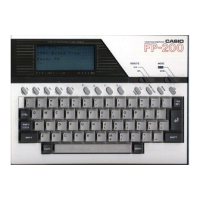
Do you have a question about the Casio FP-200 and is the answer not in the manual?
Provides an overview of the regression analysis program for forecasting sales based on historical data.
Explains how to read data from CETL or BASIC and execute the sales forecasting program.
Describes the inventory control program for managing quantities, sales, and profits using sales data.
Guides the user on creating data files, executing programs, and navigating the inventory control menu.
Details the customer management program for recording names, addresses, and contact information accurately.
Explains how to create data files and use the customer management program's menus for data operations.
Introduces X-R control charts for quality control and process analysis, used for measured values.
Explains chart preparation, data input methods (keyboard/cassette), and output options for X-R charts.
Describes the budget control program for establishing and managing budgets by account title.
Guides on using random access files, formatting disks, and navigating the budget control menus.
Explains the program for calculating installment payments for long-term loans with four different modes.
Details the payment modes including equal installments of principal, principal plus interests, add-on, and decreasing principal.
Describes the program for calculating grades, sorting records, and correcting input data for examination papers.
Explains inputting student and subject data, and specifies processing types like editing and sorting.
Explains the frequency distribution table and histogram generation for analyzing data occurrences.
Guides on starting the program, inputting data via keyboard or tape, and correcting data.
Describes the perpetual calendar program for displaying and plotting calendars for any year.
Explains using a plotter, selecting character sizes, and inputting year/month for calendar generation.
Details the program for plotting graphs from CETL data, supporting various graph types.
Explains data input methods and how the program outputs graphs and tables.
Describes the program for solving simultaneous linear equations in multiple variables.
Guides on inputting the number of variables and the coefficients/constants for simultaneous equations.
Explains vector addition and subtraction using dot-graphics to represent vectors as graphs.
Guides on inputting scales, vectors, and performing addition or subtraction operations.
Describes the disassembler for the 80C85 CPU to check memory contents and display assembly language.
Explains using a printer, inputting addresses, and displaying disassembled contents.
Provides a memory dump capability by checking memory contents using the PEEK command.
Guides on using a printer, inputting addresses, and displaying memory contents in hexadecimal.
Introduces a treasure-hunting game where players find treasures in a matrix using hints.
Explains setting up the game, inputting X/Y values, and finding treasures with scoring.
Describes a poker game played against the computer, aiming to beat the computer's hand.
Explains betting, drawing cards, and determining the winner based on hand strength.
Introduces a skiing game where players navigate a downhill course, avoiding obstacles.
Guides on controlling the skier using keys, aiming for the goal, and understanding scoring.
Describes a tank combat game where players move and shoot to destroy enemy tanks within a time limit.
Explains controlling the tank, aiming, attacking enemies, and avoiding enemy fire.
Introduces a golf game with nine holes, requiring players to get good scores.
Guides on starting the game, inputting power and angle, and understanding game conditions.
Describes the mazing game where players guide a snake through a maze to avoid obstacles.
Explains controlling the snake using keys and the game's objective to avoid blocks and obstacles.
Introduces a game to catch a chicken by enclosing it with blocks in a garden.
Guides on placing blocks to trap the chicken and understanding game rules and penalties.